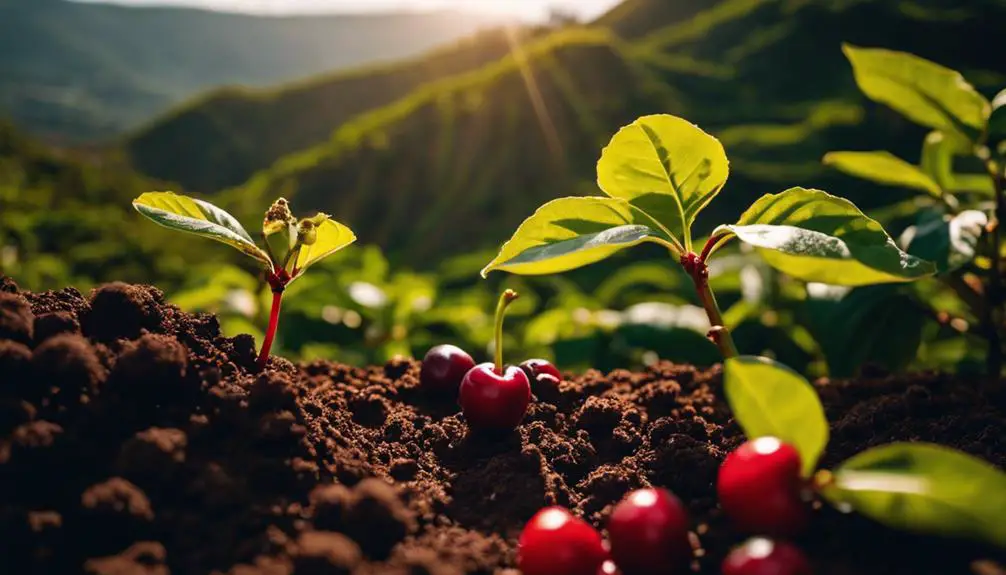When it comes to coffee, acidity is like the notes in a symphony, adding depth and complexity to your brew. But have you ever wondered what factors influence this crucial aspect of your morning cup?
From the bean’s origin to the processing methods and roasting techniques, a myriad of elements can impact the acidity of your coffee. Understanding these key influences can help you tailor your brewing methods to achieve the perfect balance of flavors.
So, why not explore the fascinating world of coffee acidity factors and unlock the secrets to brewing a truly exceptional cup?
Factors Influencing the Acidity of Coffee

When it comes to the acidity of your coffee, the origin of the beans plays a crucial role. Different coffee varieties also contribute to the varying levels of acidity you experience in your cup.
Additionally, the processing methods, roasting techniques, and brewing methods all come together to shape the acidity profile of your favorite brew.
Bean Origin and Its Impact on Acidity
When considering the acidity of coffee, the origin of the beans plays a crucial role.
Geographic location impacts the flavor profile of coffee beans, influencing their acidity levels.
Factors like soil composition, elevation, and climate all contribute to the unique acidity profiles found in coffee from different regions.
How Geographic Location Affects Acidity
Geographic location plays a significant role in determining the acidity levels of coffee beans. Factors like climate variations and altitude effects greatly influence the taste profile of coffee.
For instance:
- Unique microclimates create diverse flavor profiles.
- High altitudes foster complex acidity.
- Temperature fluctuations impact bean development.
- Proximity to the equator intensifies fruitiness.
Soil Composition and Its Role in Acidity
In understanding the acidity levels of coffee beans, the soil composition plays a crucial role, influencing the flavor profile and taste characteristics of the coffee.
- Soil acidity levels: The pH of the soil impacts the acidity of the beans.
- Nutrient content: Soil richness in specific minerals affects acidity.
- Organic matter: Decomposed materials contribute to acidity.
- Acidity in farming practices: Cultivation methods influence final acidity.
The Influence of Elevation on Acidity
The elevation at which coffee beans are grown significantly influences their acidity levels, adding another layer to the complex factors that contribute to the flavor profile of the final brew.
- Temperature effects: Higher elevations often mean cooler temperatures.
- Altitude variations: Different altitudes can result in various acidity levels.
- Pressure changes: Atmospheric pressure impacts bean development.
- Oxygen levels: Higher altitudes affect oxygen availability.
Climate Interaction and Its Effects on Acidity
Climate interactions play a crucial role in determining the acidity levels of coffee beans, showcasing how environmental conditions directly impact the flavor profile of the final brew.
- Climate Variability: Influences the development of acidity.
- Acidity Levels: Directly linked to environmental factors.
- Acidity Modulation: Varied climates result in different acidity profiles.
- Taste Balance: Achieving the perfect blend of acidity for a well-rounded coffee experience.
Acidity Profiles by Coffee Region
Exploring how different coffee regions influence the acidity profiles of beans reveals the intricate relationship between bean origin and flavor characteristics. Acidity variations and flavor nuances can be attributed to regional acidity trends, shaping distinct taste profiles.
Understanding how beans from diverse origins impact acidity offers a gateway to experiencing a spectrum of flavors, enticing those seeking innovative and unique coffee experiences.
African Coffees: Bright and Fruity Acidity
Indulge in the vibrant acidity of African coffees, where bright and fruity flavors dance on your palate, showcasing the unique impact of bean origin on coffee acidity.
- African coffees: Known for their unique flavors
- Processing methods: Influence taste profiles significantly
- Exploring acidity differences: Unveils a spectrum of tangy notes
- Taste preferences: Vary widely among coffee enthusiasts
Latin American Coffees: Crisp and Clean Acidity
Latin American coffees offer a distinctive crisp and clean acidity that sets them apart in the world of coffee flavors.
- Flavor profiles: Bright and vibrant taste notes
- Brewing techniques: Best enjoyed through pour-over or AeroPress methods
- Altitude impact: Grown at high altitudes, enhancing acidity
- Processing methods: Washed processing commonly used for a cleaner taste profile
Asian and Pacific Coffees: Earthy and Complex Acidity
Moving from the crisp and clean acidity of Latin American coffees, Asian and Pacific coffees present an earthy and complex acidity that intrigues coffee enthusiasts worldwide.
- Asian and Pacific coffees offer unique earthy flavors.
- The regional profiles of these coffees showcase a diverse range of taste experiences.
- The acidity in these coffees is often described as complex and multi-layered.
- Coffee lovers appreciate the innovative flavors found in Asian and Pacific coffees.
Coffee Varieties and Acidity
When it comes to understanding the acidity of coffee, exploring the differences between Arabica and Robusta varieties is essential. These two prominent coffee types showcase varying levels of acidity, impacting the overall flavor profile.
Additionally, specific varietal differences within each category can further influence the acidity characteristics in your cup of coffee.
Arabica vs. Robusta: Comparing Acidity Levels
Comparing the acidity levels of Arabica and Robusta coffee varieties reveals distinct differences in flavor profile and perceived sharpness. Arabica generally offers a smoother, sweeter taste with higher acidity, while Robusta tends to be more bitter and less acidic. Below is a comparison table highlighting the acidity levels of Arabica and Robusta in espresso:
| Coffee Variety | Acidity Level | Flavor Profile |
|---|---|---|
| Arabica | High | Sweet, Smooth |
| Robusta | Low | Bitter |
Specific Varietal Differences in Acidity
To further explore the nuances of acidity in coffee, consider the specific varietal differences that play a significant role in shaping the flavor profile of different types of coffee beans. When comparing acidity varietal differences, you’ll notice unique characteristics that contribute to diverse acidity flavor profiles. Understanding these distinctions can help you appreciate the complexity and depth of flavors found in various coffee varieties.
| Varied Acidity Levels | Flavor Profiles | Notable Characteristics |
|---|---|---|
| High Acidity | Bright, tangy | Citrusy, fruity notes |
| Medium Acidity | Balanced | Smooth, rounded taste |
| Low Acidity | Mellow | Nutty, chocolatey undertones |
Processing Methods and Their Effects on Acidity
When it comes to the acidity of coffee, the processing methods play a crucial role. Whether it’s the washed process offering distinct acidity outcomes or the impact of honey and other techniques, each method influences the final taste.
Understanding how the fermentation process contributes to acidity is key in appreciating the nuances of different coffee varieties.
Washed vs. Natural Process: Acidity Outcomes
The processing method used for coffee beans significantly influences the resulting acidity levels, with the washed and natural processes yielding distinct acidity outcomes. When comparing these methods, the fermentation impact and flavor development play pivotal roles in shaping the final acidity profile. Dive deeper into the differences with the table below:
| Processing Method | Fermentation Impact | Flavor Development |
|---|---|---|
| Washed | High | Clean, Bright |
| Natural | Low | Fruity, Wild |
Honey and Other Processing Techniques’ Impact on Acidity
Considering the impact of various processing techniques on coffee acidity, exploring how honey processing and other methods influence the overall flavor profile is essential.
- Honey processing enhances sweetness balance.
- Other techniques like anaerobic fermentation contribute to flavor complexity.
- Carbonic maceration can elevate acidity levels.
- Different processing methods result in unique acidity profiles, offering a diverse range of flavors for coffee enthusiasts seeking innovation.
The Role of Fermentation Process in Acidity
Ever wondered how the fermentation process impacts the acidity of your coffee? The fermentation process plays a crucial role in determining the final acidity levels of your brew. Here are some key points to consider:
- Length of fermentation affects acidity development
- Type of yeast used can influence flavor profile
- Temperature control during fermentation impacts acidity
- Oxygen exposure during fermentation can alter acidity levels
Roasting and Its Influence on Coffee’s Acidity
When it comes to coffee acidity, the roast level plays a significant role. Light roasts tend to retain more acidity compared to dark roasts.
Understanding how roasting techniques influence acidity development is crucial in appreciating the nuances of coffee flavors.
Roast Level Impact on Acidity
Roasting coffee beans to different levels directly impacts the acidity of the resulting brew. The roast level plays a crucial role in acidity perception and flavor profiles. Below is a table illustrating how different roast levels influence acidity balance in coffee:
| Roast Level | Acidity Balance | Flavor Profiles |
|---|---|---|
| Light | High | Bright, Fruity |
| Medium | Moderate | Balanced |
| Dark | Low | Bold, Bitter |
Light vs. Dark Roasts: Acidity Comparison
In comparing light and dark roasts for acidity levels, consider how the roast level directly impacts the perceived acidity in your coffee brew. The acidity perception can vary greatly, influencing your roast preference.
| Acidity Perception | Roast Preference |
|---|---|
| Bright and Vibrant | Light Roasts |
| Smooth and Mellow | Dark Roasts |
Roasting Technique and Acidity Development
To enhance the acidity of your coffee, consider how the roasting technique employed plays a significant role in the development of its vibrant flavors.
- Explore roasting nuances for optimal acidity balance
- Understand acidity development for a rich flavor interplay
- Experiment with different roast levels to enhance acidity
- Embrace innovative roasting methods for unique flavor profiles
Brewing Techniques: Adjusting Acidity
When brewing coffee, adjusting acidity is key to enhancing your coffee experience. Factors like grind size, water temperature, and brew time all play crucial roles in managing acidity levels.
Grind Size and Extraction: Effects on Acidity
Adjusting the grind size and extraction method can significantly impact the acidity of your coffee.
- Surface Area Exposure: Finer grinds increase extraction rate.
- Extraction Time: Longer extraction can extract more acidity.
- Uniformity: Consistent grind size promotes even extraction.
- Brewing Method: Various methods alter acidity levels.
Fine vs. Coarse Grind: Navigating Acidity Through Extraction
Navigating acidity levels in your coffee can be achieved by understanding the impact of using a fine versus coarse grind during extraction. When adjusting extraction for acidity levels, consider:
- Fine grind enhances acidity.
- Coarse grind reduces acidity.
- Adjust grind size based on desired acidity.
- Experiment with different extraction times for varied acidity profiles.
Water Temperature and Its Influence on Acidity
To further control the acidity levels in your coffee, consider how water temperature can significantly impact the overall acidity of your brew.
- Temperature control: Experiment with different water temperatures to find the ideal balance.
- Acidity balance: Adjust the water temperature to achieve the desired acidity profile.
- Precision brewing: Use precise temperature adjustments for consistent results.
- Innovation in brewing: Explore new methods that utilize temperature control for enhanced acidity balance.
Brew Time Adjustments to Manage Acidity
Consider adjusting the brew time to effectively manage the acidity of your coffee.
- Experiment with shorter brew times for acidity balancing.
- Try longer brew times to enhance the flavor profile.
- Monitor acidity levels closely during the brewing process.
- Fine-tune brew time based on the desired acidity level for a personalized coffee experience.
Water Quality and Its Impact on Coffee Acidity
For optimal control over the acidity of your coffee, understanding how water quality affects acidity is crucial.
- Water Filtration: Investing in a quality water filtration system can greatly impact the taste and acidity of your coffee.
- Acidity Regulation: Proper water pH levels play a significant role in regulating the acidity of your brew.
- Mineral Content: The mineral composition of water can influence the perceived acidity in your coffee.
- Consistency: Using consistent water quality ensures predictable acidity levels in your coffee.
Post-Harvest Handling, Storage, and Acidity
When it comes to the acidity of coffee, factors like the ripeness of the coffee cherry during harvest and the conditions in which the beans are handled and stored post-harvest play a crucial role. These aspects can significantly impact the final acidity profile of your coffee beans.
Understanding how post-harvest handling and storage conditions influence acidity is key to appreciating the complexity of your cup of coffee.
Coffee Cherry Ripeness at Harvest and Acidity
Ripeness of coffee cherries at harvest significantly influences the acidity profile of the resulting coffee beans.
- Harvest timing plays a crucial role in determining acidity levels.
- Maturation impact on coffee acidity is key.
- Optimal ripeness enhances the vibrancy of acidity.
- Underripe cherries may result in a flat acidity profile.
Post-Harvest Handling and Storage Conditions’ Impact on Acidity
The handling and storage conditions after harvesting coffee cherries significantly influence the acidity profile of the final coffee beans.
- Fermentation Process Impact: Varies based on duration and method.
- Storage Conditions Analysis: Temperature, humidity, and container type play vital roles.
- Air Exposure: Oxygen levels impact acidity development.
- Moisture Content Control: Influences fermentation and acidity levels.
Bean Age and Storage Conditions
When it comes to the acidity of coffee, the age of the beans matters. Older beans tend to lose their acidity over time, resulting in a milder flavor profile.
Additionally, how you store your coffee beans can also impact their acidity levels. Improper storage conditions, such as exposure to light, air, or moisture, can lead to a decrease in acidity and a loss of flavor complexity.
How Bean Age Influences Acidity
Exploring how the age of coffee beans influences acidity reveals crucial insights into the flavor profile of your brew.
- Bean age impact on acidity levels
- Flavor development over time
- Optimal storage conditions for acidity preservation
- Innovative methods for enhancing acidity profile
Storage Conditions and Their Effect on Acidity
Considering the impact of storage conditions on acidity levels, how you store your coffee beans can significantly influence the flavor profile of your brewed coffee.
- Optimal storage is crucial
- Acidity preservation is key
- Temperature control is vital
- Acidity retention is essential
Types of Acids in Coffee and Their Flavor Profiles

When exploring types of acids in coffee and their flavor profiles, you’ll encounter a spectrum of tastes, from citric to malic and more.
Understanding these acids is crucial as they contribute to the complexity of your coffee’s flavor profile.
Embrace the diverse range of flavors these acids bring to your cup, enhancing your coffee experience.
Citric, Malic, and More: A Flavor Spectrum
Discover the diverse flavor profiles of citric, malic, and other acids found in coffee. These acids contribute to the complexity and richness of your coffee experience. Here are some key flavor profiles to consider:
- Citric Acid: Provides bright, citrusy notes that can enhance the overall acidity balance of the coffee.
- Malic Acid: Offers tart flavors reminiscent of green apples, adding a crispness to the brew.
- Phosphoric Acid: Creates a unique sweetness and can give the coffee a soda-like quality.
- Quinic Acid: Contributes to a slightly bitter taste, often associated with over-extracted brews.
Understanding these acid profiles can help you delve deeper into the intricate world of coffee flavors and elevate your flavor perception.
The Relationship Between Acids and Coffee’s Complexity
Exploring the diverse types of acids present in coffee and their unique flavor profiles enhances your understanding of the complexity that contributes to the overall coffee experience. When considering the relationship between acids and coffee’s complexity, the following aspects are key to appreciate:
- Acidity balance is crucial in determining the overall flavor profile.
- Different acids present in coffee contribute distinct flavor notes.
- Understanding the role of acids can elevate your sensory experience.
- The interplay of various acids creates a multifaceted taste sensation.
Frequently Asked Questions About Coffee Acidity

Curious about coffee acidity? Wondering what factors affect the acidity of your brew or how to adjust it to your liking?
Explore questions like whether finer ground coffee is more acidic and what chemicals in coffee contribute to its acidity in the following points.
What Factors Make Coffee More or Less Acidic?
Understanding the factors that influence the acidity levels in coffee can significantly impact your brewing experience and flavor preferences. When it comes to making coffee more or less acidic, consider the following:
- Bean Origin: The geographical location where the coffee beans are grown can affect acidity levels.
- Roasting Profile: Lighter roasts tend to preserve more acidity compared to darker roasts.
- Processing Methods: Washed process coffees generally have higher acidity levels than natural process coffees.
- Brewing Time and Temperature: Adjusting the brewing time and temperature can impact the extraction of acids from the coffee grounds.
How Can I Adjust the Acidity of My Coffee?
To adjust the acidity of your coffee, consider experimenting with different brewing methods and ratios to find the ideal balance for your taste preferences. When looking to adjust brew acidity levels and achieve the perfect flavor balance, innovative brewing techniques can make a significant difference. Here are some tips to help you customize the acidity of your coffee:
- Cold Brew: Try cold brewing your coffee for a smoother, less acidic flavor profile.
- Pour-Over Method: Experiment with a pour-over method to control the brewing time and extraction process.
- Adjust Grind Size: Alter the grind size of your coffee beans to impact the acidity levels.
- Water Temperature: Explore the effect of water temperature on acidity by adjusting it during brewing.
Is Finer Ground Coffee More Acidic?
When considering the acidity of coffee, the fineness of the ground beans can impact the overall tartness of the brew. Here’s how grind size influences the acidity of your coffee:
- Grind Size Impact: Finer grounds increase surface area, intensifying extraction and potentially boosting acidity.
- Flavor Balance: The right grind size can help achieve a balanced flavor profile, enhancing acidity perception.
- Acidity Perception: Smaller particles can lead to a perception of increased acidity due to quicker extraction.
- Extraction Process: Fine grinding can influence the extraction process, affecting how acids are released into the final cup.
Experimenting with different grind sizes can offer insights into how to manipulate acidity levels while maintaining a harmonious flavor balance in your coffee.
What Chemicals in Coffee Contribute to Acidity?
Exploring the chemical components present in coffee can provide valuable insights into the factors contributing to its acidity levels. Some key chemical compounds in coffee that contribute to its acidity and affect taste perception include:
- Chlorogenic acids: These compounds are found in high amounts in green coffee beans and decrease during the roasting process.
- Quinic acid: Formed during the roasting process, it contributes to the perceived acidity in coffee.
- Citric acid: Naturally present in coffee, it adds a citrusy note to the overall flavor profile.
- Acetic acid: Found in trace amounts, it can influence the overall perceived acidity of the brew.
Understanding these chemicals can help you appreciate the complex interplay of flavors in your cup of coffee.
Strategies for Reducing Acidity in Your Brew
Consider adjusting your brewing method to reduce the acidity in your coffee for a smoother taste experience. When looking to balance acidity and enhance flavor, try out these acidity reduction techniques:
- Cold brewing: Steep coffee grounds in cold water for an extended period to extract flavors more gently.
- Using a coarser grind: Opt for a coarser grind size to decrease extraction, leading to lower acidity levels.
- Brewing with a French press: This method allows for a longer steep time, resulting in a less acidic brew.
- Adding milk or cream: The proteins in dairy can help neutralize acidity, creating a creamier texture.
Experimenting with these brewing methods can help you find the perfect balance for a more enjoyable coffee experience.
Conclusion
So, now you know all about the factors that influence the acidity of your coffee.
Remember, it’s not just about the type of beans or brewing method – it’s also about the altitude and soil where they were grown.
Don’t forget to consider the roast level too, as it can greatly impact the overall acidity of your brew.
Keep these tips in mind next time you’re enjoying a cup of joe and you’ll be sure to have a deliciously balanced experience!

















